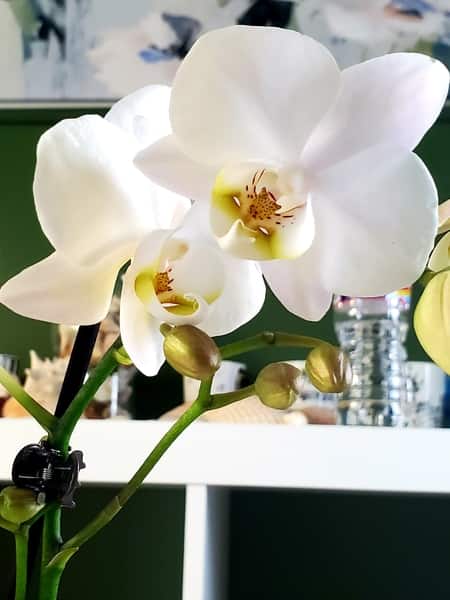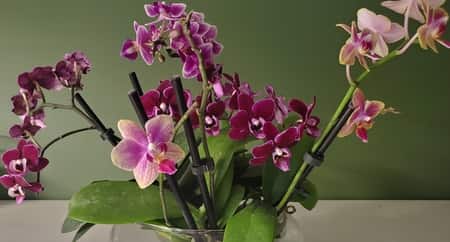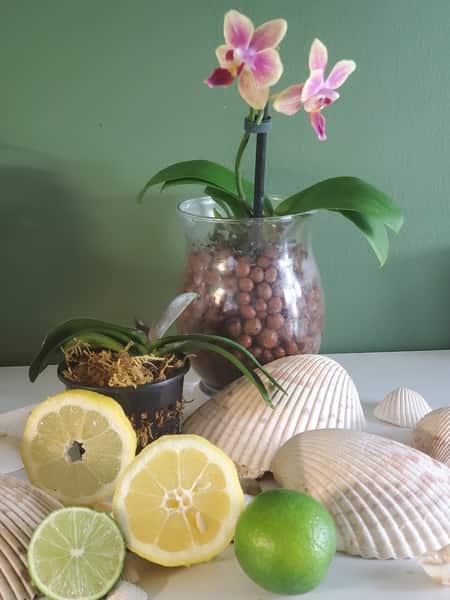In this guide, you’ll learn how to fertilize orchids in 3 types of water culture (Full Water Culture, Semi Water Culture and Semi Hydroponics) and how that affects the growth cycle of your orchid.
One of the biggest doubts about growing orchids in water culture (after the initial fear that the orchid will die in just water) is how to go about fertilizing them. In a pot with organic material such as orchid bark, sphagnum moss, perlite, and charcoal, the fertilization is usually weekly weakly. This is very vague to start with.
In short, there are three main types of water culture methods, and fertilization will be different in each method. In full water culture, the orchid receives fertilizer after the water change and an initial watering. In semi water culture, the fertilizer will be dissolved in the water that it sits in. In semi hydroponics, the fertilizer needs to be added then flushed with each watering.
Let’s look at each one of these eater culture set-ups more in depth.
Since each method is different, I won’t go in-depth on how to go about each one and repeat myself, just how to fertilize. If you are unsure of what method you are using, check out this article I wrote a couple of months back. It will give more advice on each method and how to set each one up.

The orchids in the back are in water culture… but not clear glass vases like they should be. The orchids in the front are Sphagnum Moss.
Fertilizing Orchids in Full Water Culture
First off, full water culture DOES NOT mean that the orchid sits in water 24/7. I read an article just this morning where the blogger stated that. I was shocked… Do NOT do this. For more information on full water culture, this article is a guide I wrote explaining how to set up the full water culture system.
Your orchid will rot if you keep it in water all the time. Every orchid needs a drying out period, independent of the genera or species. There are no aquatic orchids, yet some will thrive in a more humid environment.
Full water culture means the orchid will sit in water 1/3 of the vase-height for 5 days and dry out for 2 days. There IS A DRYING OUT period of two days. The bottom part of the vase will constantly have water in it most of the time, and that is where the name FULL WATER CULTURE comes from.
In this method, the main purpose of the roots is to absorb the humidity that evaporates from the roots the quantity of water is extremely low at all times. There is not much contact with water, just water droplets that evaporate inside the glass vase.
To fertilize your orchid in full water culture, you need to make sure the fertilizer you are using is extremely diluted, more so than other methods on here. After the 2-day drying out period, water your orchid with a tiny jet of water just to raise the humidity around the roots and signal that it’s time to start absorbing.
The roots will be silvery or light-gray at this time and as soon as you spray them or mist them with that initial jet of water, you can apply the fertilized water. Let the fertilized water sit in the pot for a couple hours, never longer than a day, then replace the water with distilled water, reverse osmosis water, rainwater, or the water that you normally use (without fertilizer).
For a good idea of what water is best for your orchid, read this article about hard and soft water. If the orchid sits in fertilized water for 5 days straight, the roots will absorb too much fertilizer.
Some minerals and elements that are necessary for the orchid will also evaporate during that period, which means that the roots that are not in direct contact with the water will still absorb the nutrients through the evaporation process. The quantity will be very high, which is why I have to put such a strong emphasis on not using a lot of fertilizer.
Fertilizing Orchids in Semi Water Culture

Mini Phalaenopsis in Semi Water CultureIn semi water culture, the levels of the water will be higher but will be in the vase for a shorter period of time. For 2 days straight, you will keep your orchid in water almost up to the upper part of the roots but not touching the stem.
In Semi water Culture (SWC), the water levels fill the vase, giving the roots a good drinking, but then allowing them to sit in a dry vase for the next 5 days.
Since there is not evaporation process in Semi Water Culture, the only way the orchid will get its fertilized nutrients is when you apply the water. There will be more water to evenly distribute the elements that the orchid needs, so you’ll still need to use a light hand when fertilizing. The same water you use in the fertilizing process is the same water that the orchid will sit in for 2 days.
Again, use a very light hand in fertilizing. Orchids do not need a lot of fertilizer and do better off being under fertilized than overfertilized.
After two days, any opportunity that the orchid had to absorb nutrients is now gone. There is no water at the bottom of the vase to evaporate, so the chances this orchid had to absorb nutrients are null.
In this method, allow one day of the week to not use fertilized water, allowing the orchid to drink water that has a PPM (parts per million) count close to zero. This allows the orchid to take a mineral break.
Fertilizing Orchid in Semi Hydroponics (Leca Beads)

Semi Hydroponics Next to Sphagnum MossWith semi hydroponics, the orchid roots will be in contact with the leca beads which absorb water. Even though the are not humid or wet all the time, they have constant access to the water. Humidity inside the pot will be high. To know more about how semi hydroponics works and how to transfer your orchid to semi hydroponics, look at this article.
In summary, there is always a small layer of water at the bottom of the pot in semi hydroponics which makes fertilization a constant. Just like having orchid bark or sphagnum moss in the pot at all times, the leca beads will absorb the fertilizer and release it slowly.
In this water culture method, you will need to flush your orchid pot frequently. Flushing is another term for rinsing out your orchid pot with water that hasn’t been fertilized, so the extra salt build-up and mineral build-up can be rinsed out of the pot.
The excess minerals and nutrients will build up more in Semi Hydroponics, more so than in the other water culture methods. This is why it is important to keep your orchid healthy and away from high levels of sodium and other salt compounds.
I know some orchid lovers who will flush there semi hydroponic orchids weekly. Before each addition of water, they will rinse the pot out thoroughly, then apply water with fertilizer. The water needs to fill the top of the top and run over the sides so the extra minerals can be drained.
Since there are holes on the sides of your pot, you’ll need to either more water until it fills up to the rim, or cover the holes. Either way is fine as long as you rinse the leca out.
What Do Orchids Need in their Fertilizer?
Do not just use a fertilizer that has only N-P-K in it (Nitrogen, Phosphorous, or Potassium). If you are on a budget, I suggest only investing in one other product that has a high rate of calcium and magnesium.
You can also use homemade fertilizers, like in this article about eggshells, or this other one about tea bags. There are several types of fertilization methods that you can use with orchids, and you mist want to try misting, which I mention there but not in this article.
I didn’t mention misting because I have not tried it with water culture orchids. I have only tried it with potted orchids and it seems to be working. I still prefer mixing fertilizer (diluting) in water, but that’s me.
Whatever you use, do not use all the minerals at the same time. Use a steady fertilizer weekly, or three out of the four weeks, and supplements others on a schedule so they are less frequently used. After all, they are micronutrients and the orchid doesn’t need them as much. On the other hand, use Calcium every time you have a chance.
You can also try out Epsom Salts, which does provide a lot of nutrients that your orchid needs. Check out this article about Epsom Salts, where I explain what is beneficial or not and in what doses.
In order to understand what your orchid needs, below is a list of the nutrients divide into two groups. One is called micronutrients and the other is called macronutrients. (Source )
)
If you look these up in health books, the list will be different elements, because the reference is to what the orchid needs in macro and micro proportions. In health books, the list is what we need as humans.
If you have more money to spare, look for products with the list of elements below.
| Macronutrients | Micronutrients |
Carbon (C) | Iron (Fe) |
Hydrogen (H) | Manganese (Mn) |
| Oxygen (O) | Boron (B) |
Nitrogen (N) | Molybdenum (Mo) |
| Phosphorus (P) | Copper (Cu) |
| Potassium (K) | Zinc (Zn) |
| Calcium (Ca) | Chlorine (Cl) |
| Magnesium (Mg) | Nickel (Ni) |
Sulfur (S) | Cobalt (Co) |
Sodium (Na) | |
| Silicon (Si) |
Don’t Stop Learning!
If you want to be included in more information and get a 14-page fertilization guide, please sign up for my newsletter. I don’t spam, but send emails out bi-monthly with some curious topics of interest. If you want more information, click here to go to a specific page on this website where I explain it more in detail.

Also, if you are looking for an orchid journal to keep your notes specifically about orchid care, check out my 2 solutions for that on this page. If note-keeping isn’t your thing, then there is a free excel spreadsheet that you can download. Click here for more information on how to do that.
If you subscribe to my newsletter, I will send you a 14-page guide on the main tips of orchid fertilizer. It is downloadable and you can print it out on your computer. I designed the guide to double up as a coloring book, just to make it fun.
To sum it all up, these are the 3 ways that your orchid can be fertilized in Water Culture. If you happen to have an orchid in pure sphagnum moss and not orchid bark, the process is very different. You can read that process in this article.
Below are the articles I mentioned during the course of this tutorial. I mention them here again because I always found it hard to go back and find the article I wanted to read after I was done.
Water culture: Complete Guide for Beginners
How to Transfer Orchids to Semi Hydroponics
How to Transfer Orchids to Full Water Culture
How Eggshells Provide Calcium for Orchids
5 Ways to Fertilize Orchids and Understanding NPK
If you have found this article helpful, please comment below. It’s always great to interact with other orchid enthusiasts, be it a beginner level or more experienced. I by no means am an expert since there isn’t an orchid I can’t kill. We are always learning on this path of orchid care and I certainly am learning tons of new information about how to grow orchids indoors, which is a new thing for me.
I wish you the best in your orchid care! Happy Cultivating!

